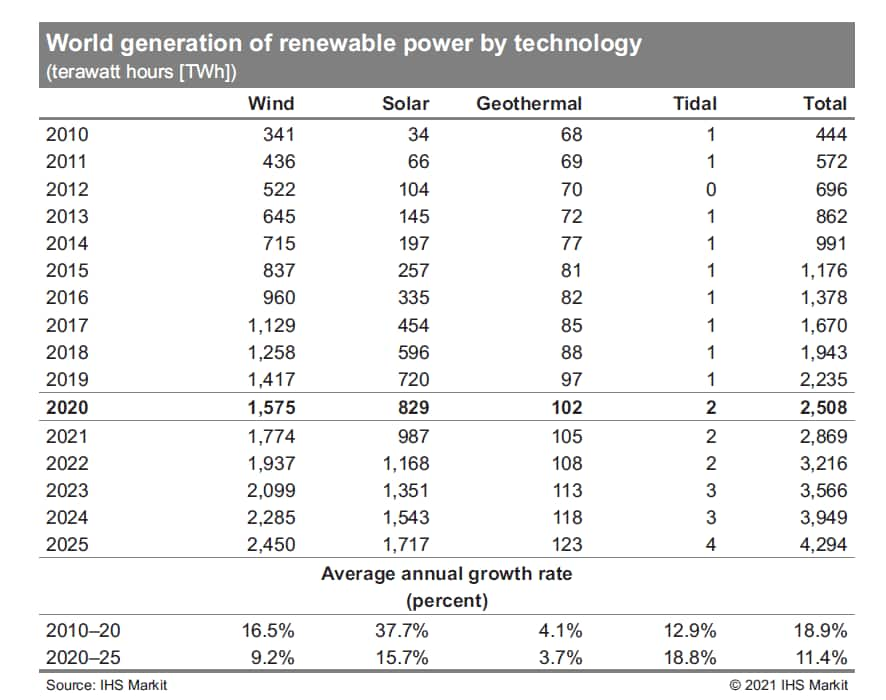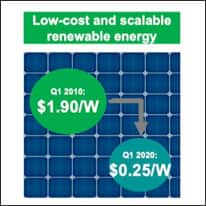Customer Logins
Obtain the data you need to make the most informed decisions by accessing our extensive portfolio of information, analytics, and expertise. Sign in to the product or service center of your choice.
Customer LoginsRenewable Energy and Cleantech: Keys to Decarbonization
Geopolitics, technology, macroeconomics, and consumer behavior, as well as climate change and government policies, all have an impact on energy markets.
Renewable energy's development remains a key driver for the decarbonization of global power markets and a major instrument in attaining the Paris Agreement's ambitious emissions reduction objective as it becomes more competitive. Renewables are also a potential choice in locations with limited or no electrical grid connectivity (primarily emerging markets).
All major energy sectors are under pressure to decarbonize—renewables will account for more than 80% of net capacity additions globally.


Large build-out of renewables requires storage facilities


The level of renewable energy development differs drastically from one country to the next. In 2020, Western Europe had the highest share of power obtained from nonhydro renewable sources, at 21.0 percent; on the other hand, the CIS and Baltic States region had just about 0.9 percent of electricity obtained from nonhydro renewable sources. Even though cost-competitiveness is increasing, government policies remain a key near-term development factor for renewables. An increased commitment from the financial community is also expected to catalyze the energy transition in the medium-term, as lenders seek more reporting information regarding the ability of business models to fare well during the transition.
Nonhydro renewable energy has expanded fast over the past decade, but it continues to be a minor contributor to worldwide power generation globally, accounting for only 9.5 percent of total in 2020. Renewable energy generation is dominated by Northeast Asia, North America, and Western Europe, with a combined share of 78.8%.
Nonhydro renewables (mostly solar and wind), which are utilized purely for power generation, will account for around 2.6 percent of overall energy mix in 2020, up from less than 1% a decade ago. Consumer awareness, government policies, and new cost-effective production methods and energy storage systems have all contributed to a modest increase in the percentage of energy derived from renewable sources.

Wind power accounted for 62.8 percent of global renewable energy production in 2020; onshore wind turbines are by far the most common source of wind energy output, with offshore wind accounting for less than 10% of total. Wind power development has benefited from improved wind turbine performance, faster operating speeds, improved turbine design, and partial repowering of existing wind farms.
Solar power is the second-largest source of renewable energy in 2020, accounting for 33.0% of total production. Solar PV modules generate the most renewable energy, whereas concentrated solar power plants (CSP) are much smaller.
Solar modules can be installed on the ground mounted or mounted on commercial or residential rooftops. Solar power's competitiveness has improved dramatically as the cost of producing PV modules has decreased dramatically (due to economies of scale and increasing average size), as well as the worldwide convergence of best practices, resulting in an increase in the number of projects and investments globally.
Total, Tesla, BP, Shell, and Apple are among the major worldwide firms investing in the solar business. Solar power investments will continue to rise over the next five years. Mainland China is the world's leading producer of solar photovoltaic panels, and it will continue to dominate global production and end-use markets. In 2020, mainland China accounted for about three-fourths of total global solar panel manufacturing capacity and one-third of demand. Other renewable energy sources are more limited. Geothermal energy is predominantly produced in Southeast Asia (Indonesia), North America, and Western Europe, accounting for only around 4.1 percent of worldwide renewable energy generation in 2020. Production of power generated from the ocean is negligible and will show little growth in the future.
Nonhydro renewable energy is predicted to grow at a rate of 11.4 percent per year over the next five years, making it the fastest-growing form of electricity generation. The growth of battery energy storage capacity is expected to be a crucial enabler for the further development of renewable energy, preventing the dumping of wind and solar electricity that cannot be used right away.
Learn more about the renewable energy industry from CERAWeek 2021 and our Climate and Sustainability suite of capabilities.
Learn more about the Top 10 Cleantech Trends of 2021 Whitepaper
Videos
Try the Global Clean Energy Technology service for yourself
Research and Thought Leadership
Stay Connected with S&P Global Experts
Get timely insights, commentary and special reports from industry leading experts and analysts
{}
{"items" : [
{"name":"share","enabled":true,"desc":"<strong>Share</strong>","mobdesc":"Share","options":[ {"name":"facebook","url":"https://www.facebook.com/sharer.php?u=http%3a%2f%2fwww.spglobal.com%2fesg%2fs1%2ftopic%2fclean-technology-renewable-energy-world.html","enabled":true},{"name":"twitter","url":"https://twitter.com/intent/tweet?url=http%3a%2f%2fwww.spglobal.com%2fesg%2fs1%2ftopic%2fclean-technology-renewable-energy-world.html&text=Renewable+Energy+and+Cleantech%3a+Keys+to+Decarbonization+%7c+S%26P+Global","enabled":true},{"name":"linkedin","url":"https://www.linkedin.com/sharing/share-offsite/?url=http%3a%2f%2fwww.spglobal.com%2fesg%2fs1%2ftopic%2fclean-technology-renewable-energy-world.html","enabled":true},{"name":"email","url":"?subject=Renewable Energy and Cleantech: Keys to Decarbonization | S&P Global&body=http%3a%2f%2fwww.spglobal.com%2fesg%2fs1%2ftopic%2fclean-technology-renewable-energy-world.html","enabled":true},{"name":"whatsapp","url":"https://api.whatsapp.com/send?text=Renewable+Energy+and+Cleantech%3a+Keys+to+Decarbonization+%7c+S%26P+Global http%3a%2f%2fwww.spglobal.com%2fesg%2fs1%2ftopic%2fclean-technology-renewable-energy-world.html","enabled":true}]}, {"name":"rtt","enabled":true,"mobdesc":"Top"}
]}
















